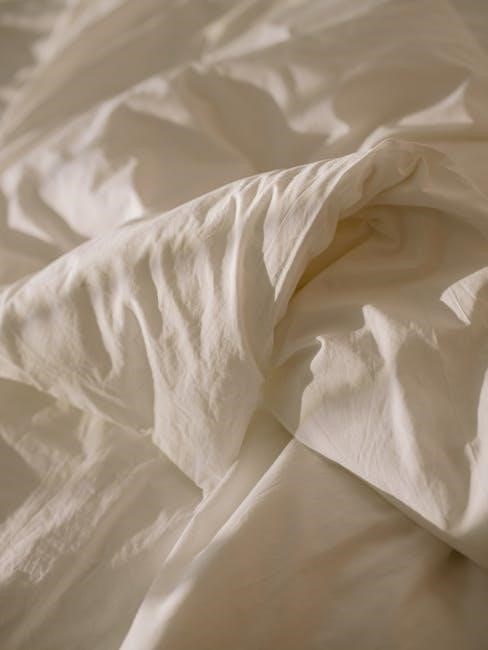A Murphy bed is a space-saving solution that folds into a wall, perfect for small rooms․ It offers versatility and comfort, ideal for modern living spaces․
1․1 What is a Murphy Bed?
A Murphy bed is a wall-mounted, foldable bed that hinges upward to store vertically against the wall, saving space when not in use․ It consists of a frame, mattress, and spring mechanism, designed to be compact and functional․ Often used in small apartments, studios, or guest rooms, Murphy beds are a practical solution for optimizing space while maintaining comfort and style․
1․2 Benefits of Installing a Murphy Bed
Installing a Murphy bed offers numerous benefits, primarily space savings, ideal for small apartments or rooms․ It allows for a multipurpose area, converting into a guest bed or additional workspace․ Murphy beds are durable, customizable to fit various decors, and provide a sleek, modern appearance․ They also enhance room functionality while maintaining comfort, making them a practical and stylish solution for optimizing living spaces efficiently․

Planning and Preparation
Measure your space, select suitable hardware, and design a detailed plan to ensure a smooth Murphy bed installation process․ Proper preparation guarantees a successful project outcome․
2․1 Measuring Your Space
Accurate measurements are crucial for a Murphy bed installation․ Measure the room’s width, height, and door openings to ensure the bed fits seamlessly․ Consider the mattress size and wall strength to support the bed’s weight․ Record all dimensions to create a precise plan, ensuring proper alignment and functionality․ This step prevents costly mistakes and guarantees a smooth installation process for your Murphy bed project․
2․2 Choosing the Right Hardware
Selecting the correct hardware is essential for a sturdy and functional Murphy bed․ Opt for a high-quality mechanism, such as spring-based or piston-based systems, ensuring it supports the mattress weight․ Hinges, screws, and brackets should be durable and designed for heavy use․ Consider adding mattress supports and straps for extra stability․ Use materials like steel for strength and longevity․ Always follow manufacturer instructions for assembly and installation to guarantee safety and reliability in your Murphy bed setup․
2․3 Designing Your Murphy Bed Plan
Designing your Murphy bed plan involves careful planning and customization to fit your space and needs․ Start by determining the bed size and style, ensuring it matches your room’s layout․ Consider the wall dimensions and door clearance for smooth operation․ Decide on the type of folding mechanism and hardware to use․ Create a detailed cut list for plywood and wood pieces, ensuring accuracy․ Plan for optional features like edgebanding, staining, or additional storage․ Customize the design to complement your room’s aesthetics, balancing functionality with personal style for a seamless fit․
Construction Steps
Construct the bed frame and platform, ensuring sturdy attachment to the wall․ Sand and stain the wood for a smooth finish before assembling all components securely․
3․1 Building the Bed Frame
Begin by constructing the bed frame using 2×2 boards for the sides and 1×8 boards for the base․ Cut the boards to the desired length and assemble them using screws and hinges․ Ensure the frame is sturdy and aligns properly with the wall brackets․ Sand the edges for a smooth finish and stain the wood to match your desired aesthetic;
3․2 Assembling the Cabinet
Start by cutting plywood pieces according to your design․ Attach edgebanding to the cut edges for a polished look․ Stain the plywood to match your desired color․ Assemble the cabinet by attaching the sides and top using screws and hinges․ Ensure proper alignment and secure the pieces tightly․ Add doors or panels to complete the cabinet, making sure they open and close smoothly․ This step ensures the Murphy bed blends seamlessly into the wall when folded․
3․3 Adding Doors or Panels
Attach doors or panels to conceal the Murphy bed when folded․ Use hinges and screws to secure them to the cabinet frame․ Ensure proper alignment for smooth operation․ Add decorative handles or magnetic catches for functionality․ Doors can be pre-made or custom-designed to match your room’s style․ Panels provide a sleek, seamless look when the bed is upright․ Double-check the fold mechanism to ensure doors or panels do not obstruct movement․ Adjust alignment as needed for a flush, even appearance that enhances both safety and aesthetics․
Installation
Attach the bed frame securely to the wall using lag bolts․ Install the folding mechanism, ensuring proper alignment and stability․ Double-check all connections for safety and functionality․
4․1 Attaching the Bed Frame to the Wall
Ensure the wall is sturdy enough to support the bed’s weight․ Locate wall studs and use lag bolts to secure the frame․ Pre-drill holes to avoid splitting wood․ Align the frame with the wall, ensuring it sits level and flush․ Tighten bolts firmly but avoid overtightening․ Double-check stability before moving on to the next step․
4․2 Installing the Folding Mechanism
Attach hinges and springs to the bed frame and wall, ensuring proper alignment․ Secure the mechanism tightly to support the bed’s weight․ Test the folding action to ensure smooth operation․ Install safety straps to prevent accidental lowering․ Follow the hardware kit instructions for precise installation; Double-check all bolts and connections for stability and safety․ This step is crucial for the bed’s functionality and durability․

Finishing Touches
Add a protective finish like polyurethane, install handles, and ensure doors are flush․ Check hardware and alignment for a polished look and smooth operation․
5․1 Sanding and Staining
Sanding and staining are crucial final touches for your Murphy bed․ Start by sanding all surfaces with medium-grit sandpaper, then progress to fine-grit for a smooth finish․ Stain the wood to match your desired color and style, ensuring even application․ Allow the stain to dry completely before applying a protective polyurethane finish․ This step enhances durability and aesthetics, giving your Murphy bed a professional look that complements your room decor․
5․2 Adding Trim and Final Adjustments
Add decorative trim to cover gaps and enhance the bed’s appearance․ Measure and cut trim pieces to fit around the cabinet and bed frame․ Attach them using nails or adhesive․ Once installed, test the folding mechanism to ensure smooth operation․ Make any necessary adjustments to hinges or brackets for proper alignment․ Finally, inspect the bed for any imperfections and touch up with paint or stain as needed to achieve a polished finish․

Hardware and Accessories
Essential hardware includes hinges, screws, brackets, and mattress supports․ Use sandpaper for smooth finishes and ensure all tools are ready for assembly and adjustments․
6․1 Necessary Tools and Materials
Gathering the right tools and materials is crucial for a successful Murphy bed project․ You’ll need a saw, drill, sandpaper, screwdrivers, a measuring tape, and a level․ For materials, choose high-quality plywood or MDF for the frame, 2×4 lumber for wall support, hinges, screws, and brackets․ Additionally, wood glue, nails, and finishing materials like stain or paint are essential․ Having everything ready ensures a smooth and efficient assembly process․
6․2 Hinges, Brackets, and Legs
Hinges, brackets, and legs are essential for a Murphy bed’s functionality․ Heavy-duty hinges enable smooth folding, while sturdy wall brackets secure the bed frame; Legs provide support when the bed is lowered․ Choose durable materials like steel or high-quality hardware to ensure safety and stability․ Proper installation of these components is critical to prevent collapse and ensure smooth operation․ They are the backbone of the bed’s mechanism, guaranteeing reliability and longevity for years of use․
6․3 Mattress Supports and Straps
Mattress supports and straps are crucial for securing the mattress in place․ Supports are typically wooden slats or platforms that hold the mattress, while straps ensure it stays fixed during folding․ Durable materials like nylon or polyester straps are recommended for longevity․ Properly attaching these components prevents the mattress from shifting or falling, ensuring safety and stability․ They work in tandem with the folding mechanism to provide a secure and comfortable sleeping surface, essential for the bed’s functionality and user safety;
A Murphy bed offers a space-saving solution, blending versatility with functionality․ Successful installation enhances any room’s efficiency, providing a practical and stylish sleeping arrangement for years․
7;1 Final Thoughts and Tips

Constructing a Murphy bed is a rewarding project that saves space and enhances functionality․ Ensure all measurements are precise and hardware is durable․ Test the folding mechanism thoroughly for safety and smooth operation․ Consider adding trim for a polished look and ensure the mattress is securely fastened․ With careful planning, your Murphy bed will become a practical and stylish addition to any room, offering comfort and convenience for years to come․
7․2 Encouragement to Start Your Project
Embarking on a Murphy bed project is an exciting venture that combines creativity with practicality․ Witnessing your design transform into a functional space-saving solution is incredibly rewarding․ By following detailed instructions and using quality materials, you’ll create a piece that enhances your home’s functionality and style․ Remember, patience and attention to detail are key to success․ Don’t hesitate to start your project—you’ll enjoy the satisfaction of a job well done and the convenience it brings to your living space․

